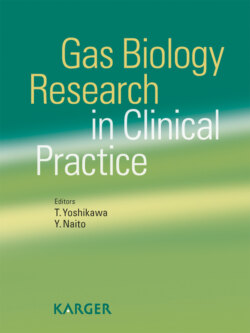Читать книгу Gas Biology Research in Clinical Practice - Группа авторов - Страница 19
На сайте Литреса книга снята с продажи.
Stomach and Duodenum
ОглавлениеSince the esophagus enters the posterosuperior aspect of the stomach, gas is trapped above liquid overlying the gastroesophageal junction in the supine position. Therefore, most swallowed air is entrapped in the stomach and can travel along the small bowel.
In the upper gut, large quantities of gas are physiologically generated from chemical reactions of hydrogen ion and bicarbonate. For 1 mEq H+ neutralized by bicarbonate in pancreatic, biliary, or duodenal secretions, 22.4 ml CO2 is produced [3]. Fat digestion causes much gastric acid secretion and would result in an estimated CO2 production rate of 1,400 ml/h. Most CO2 produced during normal digestion is absorbed along the small bowel [4]. Thus, the luminal gas in the upper digestive tract is partly swallowed and in part originates from a series of chemical reactions of the foodstuffs within the gut. Theoretically, the calculated amount of CO2 produced in the upper gut is 33.6 liters per day (1,400 ml multiplied by 24 h). However, the actual volume of CO2 liberated as gas may be far below this value owing to the slow decomposition of H2CO3 to CO2 and H2O in the absence of carbonic anhydrase and the relatively high solubility of CO2 in water [5]. Presumably, approximately 5-10 liters of CO2 seems to be produced and released into the lumen by chemical reactions.
As mentioned above, the pCO2 rises dramatically in the duodenum, resulting in diffusion of CO2 from lumen to blood, whereas CO2 in swallowed air diffuses from the blood into the stomach [6]. Because the pO2 of swallowed air is greater than that of blood in the stomach, O2 is absorbed from the stomach. The pN2 of swallowed air is slightly higher than that of venous blood in the stomach, possibly resulting in very slow absorption. In the duodenum, N2 diffuses from blood into the lumen according to the partial pressure gradient because of the down gradient established by CO2 production. In contrast, since pH2 and pCH4 are always higher in the lumen than in the blood, gases are constantly diffusing from lumen to blood. In our previous study using endoscopy, H2 and CH4 gases are more frequently detected in the stomach than expected, regardless of the presence of abdominal symptoms [7] although it has been reported that the stomach and duodenum harbor very low numbers of microorganisms adhering to the mucosal surface, typically less than 103 bacteria cells per gram of counts [8]. Fried et al. [9] reported that most of the bacteria identified from the duodenal aspirates belonged to species colonizing the oral cavity and pharynx, suggesting a descending route of colonization. Also, Thompson et al. [10] indicated that fermentation of ingested carbohydrate by oropharyngeal bacteria could contribute to measured breath hydrogen values soon after meal ingestion. Moreover, intraduodenal H2 levels were higher in patients with severe atrophic gastritis than those without atrophic gastritis, and there was a progressive increase with the progression of atrophic gastritis [11]. In contrast, the intragastric H2 level was the highest in patients with gastric mucosa of the closed type and was significantly higher than in those with severe atrophic gastritis. These results suggest that extensive atrophic gastritis may be more closely related to bacterial overgrowth in the jejunum, compared to that in the stomach.
